Even Washingtonians whose daily pursuits rarely take
them to the Mall regard this magnificent open expanse as the heart of
the city. A grassy park with carefully preserved trees, the Mall
stretches 2.5 miles (4 km) from the Capitol to the east to the Potomac
River, just beyond the Lincoln Memorial, to the west. Alongside and
nearby are the core symbols of the city and the nation: memorials to
past suffering and triumphs, the workplaces of the federal government,
and the Smithsonian Institution museums, entrusted with “the increase
and diffusion of knowledge.” The Mall also serves as a national public
square – it fills to capacity for the dazzling Fourth of July
celebration and fireworks display, while the Smithsonian Folklife Festival
brings food, dance, storytelling, and crafts from all over the world.
And the space is enlivened daily with ordinary people jogging,
strolling, or just enjoying the extraordinary views.
|
The area now known as the
Federal Triangle was developed during Franklin D. Roosevelt’s
administration and improved by John F. Kennedy. Before then, the
three-sided site, between 6th and 14th Streets and Pennsylvania and
Constitution Avenues NW, was a run-down area. Its main buildings are the
Federal Trade Commission, the National Archives, the Department of
Justice, the Internal Revenue Service, the R. Reagan Building and
International Trade Center.
|
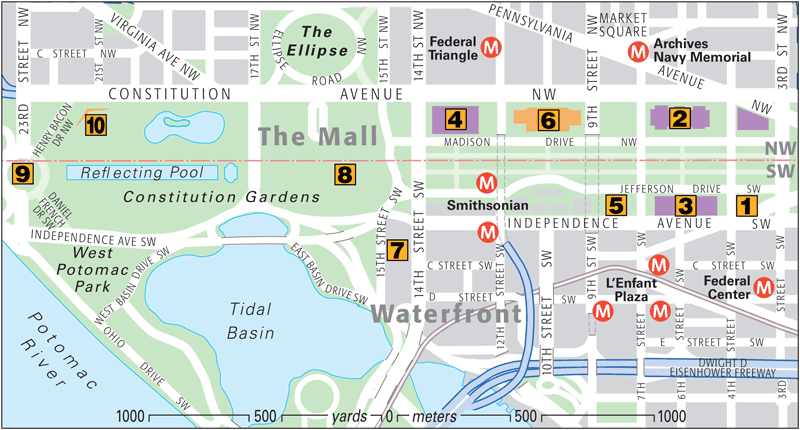
SightsNational Museum of the American Indian This
fascinating museum enshrines 10,000 years of Native American life and
culture, and acknowledges the contributions native peoples have made to
the history of the Americas. The collection includes over 800,000 items,
7,000 of which are on display. Exhibits include pre-Columbian gold
figurines, beadwork, textiles, and pottery from the Arctic to Patagonia.
The building itself has been designed in harmony with Native American
cultural beliefs. The entrance faces east to meet the morning sun, and
light spills in reflecting the importance of the sun within Amerindian
culture . National Gallery of Art Stroll
through this building surrounded by illustrious artworks dating from
before the Renaissance to the current day. The sculpture garden is a hit
for its outdoor setting, summer jazz concerts, a winter ice-skating
rink, and café. National Air and Space Museum The
story of flight, one of the most stirring in human history, is
dramatically depicted in this favorite museum, renowned for its
collection of precious artifacts of the challenging experience of flying . National Museum of American History The
story of the United States of America, from its beginnings to the
present day, is told here, through public icons and examinations of the
daily lives of ordinary people. The museum underwent renovation in 2008,
and some of the new exhibits include The Hall of Power Machinery, the
John Bull Locomotive, and the new Star-Spangled Banner Gallery. “America
on the Move” draws on the museum’s unparalleled collections and looks
at all the modes of transportation from 1876 to the present .
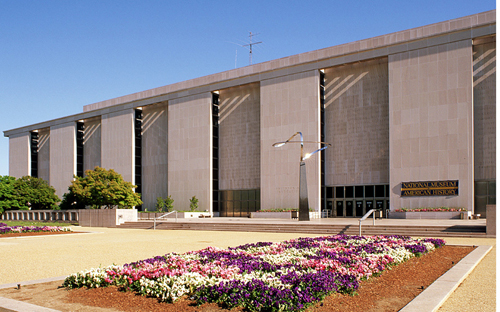
National Museum of American History
Hirshhorn Museum and Sculpture Garden The
only public gallery in the city with the sole focus on modern and
up-and-coming art, this museum’s holdings and exhibitions of
contemporary inter national works are exceptional. The unusual circular
building, designed by Gordon Bunschaft and completed in 1974, provides a
striking setting for outdoor sculpture in the surrounding plaza.
Another fine sculpture garden across Jefferson Drive displays more than
60 pieces of large-scale contemporary work .
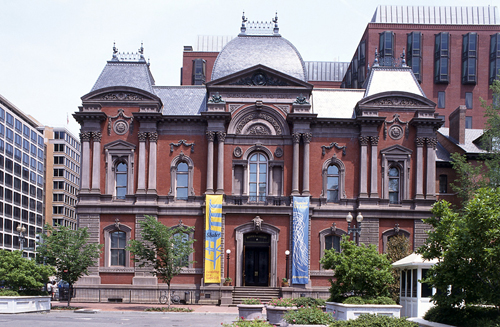
Central Plaza, Hirshhorn Museum
National Museum of Natural History
A favorite with
children, yet filled with fascinating displays and artifacts that appeal
to everyone, the vast halls of this Smithsonian museum have everything
from the tiny bones of a snake to a giant ritual statue from Easter
Island. Other exhibits include the vast Mammal Hall, Pacific island
canoes, fabulous gemstones, a giant squid, a scene from a Chinese opera,
and an Egyptian mummy case .
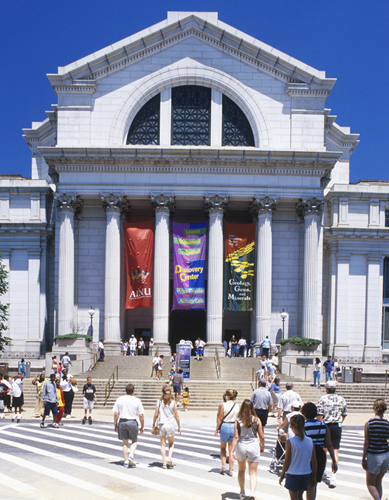
Museum of Natural History
United States Holocaust Memorial Museum Among
the city’s most challenging sites, this museum is both a working study
center for issues relating to the Holocaust and a national memorial for
the millions murdered by the World War II Nazi government. The museum is
solemn and respectful while engrossing and highly informative. Free
timed passes are required to view the three-story permanent exhibition;
special exhibitions, including the child-oriented “Remember the
Children: Daniel’s Story” can be seen without passes. 100 Raoul Wallenberg Place, SW (14th St between Independence Ave & C St, SW) Open 10am–5:30pm daily; closed Yom Kippur, Dec 25 Dis. access Free
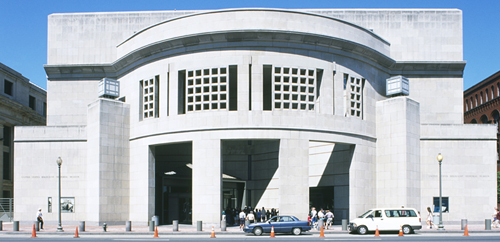
United States Holocaust Memorial Museum
Washington Monument The
plain Egyptian design of this radiant spire was largely the result of
congressional cost-cutting, but now it seems an inspired choice. At 555
ft (165 m), the monument, built to honor the first president of the
United States, towers over everything in the neighborhood. The view from
the observation platform at the top, reached by a 72-second elevator
ride, is unforgettable. The new elevator on the descending trip allows
visitors to see some of the many commemorative stones that have been
laid in the masonry walls.
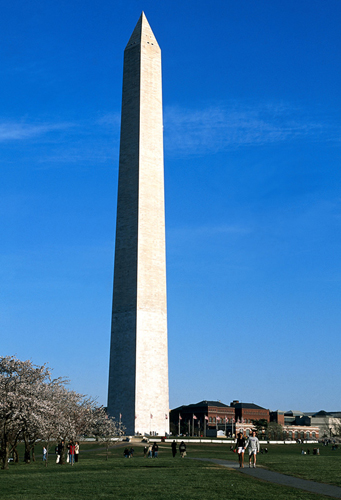
Washington Monument
Lincoln Memorial This
imposing marble memorial honors the US president who carried the
country through its most difficult era. Designed by Henry Bacon
(1866–1924) and featuring a monumental 19-ft (6-m) high statue of the
seated Lincoln by Daniel Chester French (1850–1931), the memorial was
dedicated in 1922. The Greek architecture reflects the ideals of its
time .
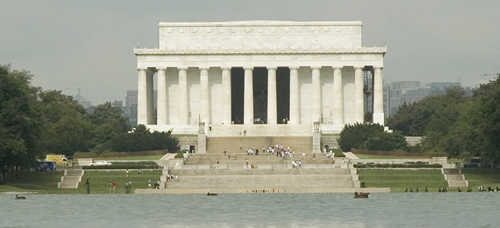
Lincoln Memorial
Vietnam Veterans’ Memorial This
stark remembrance features a black polished wall on which are carved
the names of those who died during the Vietnam War. Controversial when
it opened, because of its minimalism and because it failed to glorify
the war, the memorial has become one of the world’s most popular. Its
creator, Maya Lin, was a 21-year-old Chinese-American student when she
completed the design. More traditional statues were added in 1984.
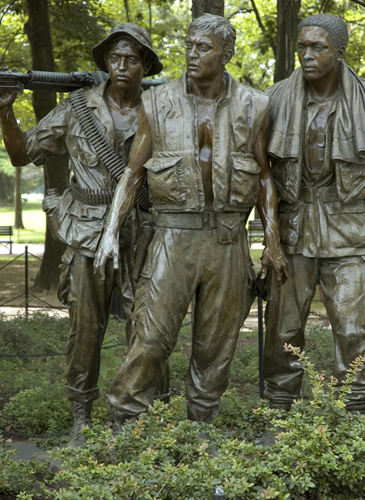
Statues, Vietnam Veterans’ Memorial
|